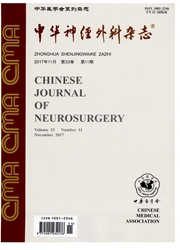

 中文摘要:
中文摘要:
目的探讨采用听性脑干反应和纯音听阈对早期诊断听神经瘤的临床应用价值。方法回顾性分析了111例听神经瘤患者的临床资料、纯音听阈、听性脑干反应及增强磁共振结果,采用线性回归分析纯音听阈均值与肿瘤体积、病程是否存在相关性,采用卡方检验分析不同肿瘤体积在听性脑干反应异常发生率上是否存在差异。结果听神经瘤引起感音神经性耳聋,纯音听阈均值与病程存在显著地相关性(P=0.000);听性脑干反应诊断听神经瘤的敏感度和特异度分别为98.2%和93.6%,肿瘤最大径〉3cm与≤3cm两组,在患侧和对侧Ⅲ~Ⅴ波间期异常发生率上,差异均具有统计学意义(P值分别为0.038和0.045)。结论听I生脑干反应联合纯音测听是早期诊断听神经瘤的有效方法。
 英文摘要:
英文摘要:
Objective To investigate the clinical application value of using auditory brainstem response and pure tone audiometry for early diagnosis of acoustic neuroma. Methods The clinical data, the results of pure tone audiometry, auditory brainstem response, and enhanced MRI in Ⅲ patients with acoustic neuroma were analyzed retrospectively. Linear regression analysis was used to analyze the correlation between the mean value of pure tone audiometry and the neuroma volume or course of disease. Chi-squared test was used to analyze the whether there were differences in the different neuroma volumes on the incidence of abnormal auditory brainstem response. Results Acoustic neuroma caused sensorineural deafness. There was a significant correlation between the mean value of pure tone audiometry and the course of disease ( P = 0. 000 ). The sensitivity and specificity of auditory brainstem response for the diagnosis of acoustic neuroma were 98.2% and 93.6% respectively. The maximum diameters of neuromas were divided into 2 groups : 〉 3 cm or ≤3 cm. There were significant differences on the abnormal incidence of the Ⅲ to Ⅴ wave intervals of the ipsilateral and contralateral ears (P = 0. 038 and 0. 045 respectively). Conclusion Auditory brainstem response in combination with pure tone audiometry is the effective method for early diagnosis of acoustic neuroma.
 同期刊论文项目
同期刊论文项目
 同项目期刊论文
同项目期刊论文
 期刊信息
期刊信息
